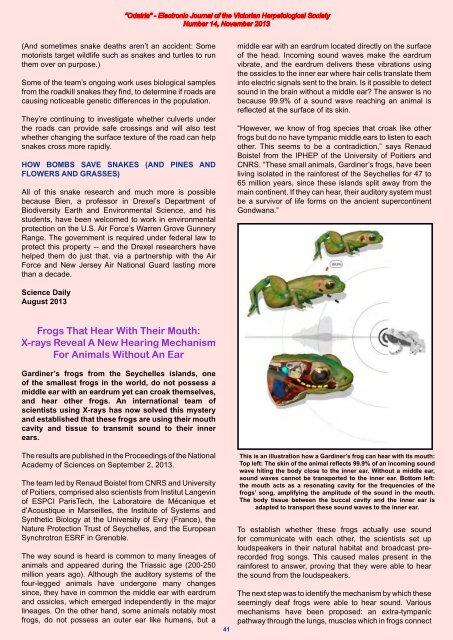Odatria_14_NOV13 - Victorian Herpetological Society
Odatria_14_NOV13 - Victorian Herpetological Society
Odatria_14_NOV13 - Victorian Herpetological Society
You also want an ePaper? Increase the reach of your titles
YUMPU automatically turns print PDFs into web optimized ePapers that Google loves.
(And sometimes snake deaths aren’t an accident: Somemotorists target wildlife such as snakes and turtles to runthem over on purpose.)Some of the team’s ongoing work uses biological samplesfrom the roadkill snakes they find, to determine if roads arecausing noticeable genetic differences in the population.They’re continuing to investigate whether culverts underthe roads can provide safe crossings and will also testwhether changing the surface texture of the road can helpsnakes cross more rapidly.HOW BOMBS SAVE SNAKES (AND PINES ANDFLOWERS AND GRASSES)All of this snake research and much more is possiblebecause Bien, a professor in Drexel’s Department ofBiodiversity Earth and Environmental Science, and hisstudents, have been welcomed to work in environmentalprotection on the U.S. Air Force’s Warren Grove GunneryRange. The government is required under federal law toprotect this property -- and the Drexel researchers havehelped them do just that, via a partnership with the AirForce and New Jersey Air National Guard lasting morethan a decade.middle ear with an eardrum located directly on the surfaceof the head. Incoming sound waves make the eardrumvibrate, and the eardrum delivers these vibrations usingthe ossicles to the inner ear where hair cells translate theminto electric signals sent to the brain. Is it possible to detectsound in the brain without a middle ear? The answer is nobecause 99.9% of a sound wave reaching an animal isreflected at the surface of its skin.“However, we know of frog species that croak like otherfrogs but do no have tympanic middle ears to listen to eachother. This seems to be a contradiction,” says RenaudBoistel from the IPHEP of the University of Poitiers andCNRS. “These small animals, Gardiner’s frogs, have beenliving isolated in the rainforest of the Seychelles for 47 to65 million years, since these islands split away from themain continent. If they can hear, their auditory system mustbe a survivor of life forms on the ancient supercontinentGondwana.”Science DailyAugust 2013Frogs That Hear With Their Mouth:X-rays Reveal A New Hearing MechanismFor Animals Without An EarGardiner’s frogs from the Seychelles islands, oneof the smallest frogs in the world, do not possess amiddle ear with an eardrum yet can croak themselves,and hear other frogs. An international team ofscientists using X-rays has now solved this mysteryand established that these frogs are using their mouthcavity and tissue to transmit sound to their innerears.The results are published in the Proceedings of the NationalAcademy of Sciences on September 2, 2013.The team led by Renaud Boistel from CNRS and Universityof Poitiers, comprised also scientists from Institut Langevinof ESPCI ParisTech, the Laboratoire de Mécanique etd’Acoustique in Marseilles, the Institute of Systems andSynthetic Biology at the University of Evry (France), theNature Protection Trust of Seychelles, and the EuropeanSynchrotron ESRF in Grenoble.The way sound is heard is common to many lineages ofanimals and appeared during the Triassic age (200-250million years ago). Although the auditory systems of thefour-legged animals have undergone many changessince, they have in common the middle ear with eardrumand ossicles, which emerged independently in the majorlineages. On the other hand, some animals notably mostfrogs, do not possess an outer ear like humans, but a41This is an illustration how a Gardiner’s frog can hear with its mouth:Top left: The skin of the animal reflects 99.9% of an incoming soundwave hiting the body close to the inner ear. Without a middle ear,sound waves cannot be transported to the inner ear. Bottom left:the mouth acts as a resonating cavity for the frequencies of thefrogs’ song, amplifying the amplitude of the sound in the mouth.The body tissue between the buccal cavity and the inner ear isadapted to transport these sound waves to the inner ear.To establish whether these frogs actually use soundfor communicate with each other, the scientists set uploudspeakers in their natural habitat and broadcast prerecordedfrog songs. This caused males present in therainforest to answer, proving that they were able to hearthe sound from the loudspeakers.The next step was to identify the mechanism by which theseseemingly deaf frogs were able to hear sound. Variousmechanisms have been proposed: an extra-tympanicpathway through the lungs, muscles which in frogs connect


